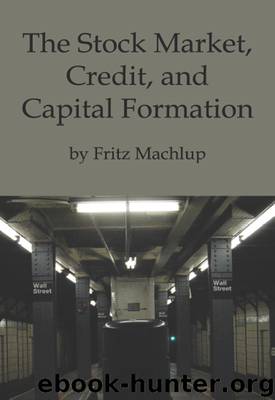The Stock Market, Credit and Capital Formation by Fritz Machlup

Author:Fritz Machlup
Language: eng
Format: epub
ISBN: 9781610160506
Publisher: William Hodge and Company, Limited
CHAPTER XII
CREDIT CREATION AND THE ATTEMPT TO DETERMINE ITS PROPER LIMITS
75. The view expressed here that credit expansion is liable to end with a crisis is not one that is shared by all economists. It may be emphasized once again that it is not, of course, the credit itself which is “dangerous.” The bank credit created by the note issuing banks and the commercial banks may in the aggregate comprise a very considerable proportion of the total circulation (i.e., the circulation of money including checking deposits) and it would be courting ridicule to claim that this “fiduciary circulation” is dangerous. It is not dangerous any longer. It exerted its effects earlier at the time of its creation, and by now has long been a part of the circulation of means of payment which is entirely harmless and is even necessary in order that the existing price structure may be maintained.
The reason why there are so many misunderstandings and differences of opinion in this sphere of banking theory is that it is a sphere where problems relating to the supply of money and the price level converge with problems relating to the demand for capital and the level of interest rates. The double rôle of bank money as a medium of payment and as money capital has paved the way for a great deal of confusion which many authors seem unable to escape. The muddle is avoided if it is made perfectly clear that bank money functions directly as money capital at the time of its creation by new bank loans and investments. After it has been used as money capital by the entrepreneur who obtained it in the first instance, it becomes part of the general stream of money, and flows in and out of the cash holdings of the various members of the exchange economy, by becoming part of their money income. It can act as money capital a second and third time only when it becomes part of the voluntary savings of an income recipient who forgoes present consumption.1
The double role of money: as circulating medium it affects prices, as money capital it affects interest rates.
It acts as money capital when it is created by loans and investments,—
—and later again only when it is saved out of income.
The creation of bank money (i.e., the granting of new loans or the purchasing of securities by a bank) exerts its effect, like all additions to the supply of money capital, on the rate of interest and on the structure of production. The continued existence of bank money that was created previously (and, of course, has had its short-run effects) is neutral towards the credit market and the structure of production. The creation and continued existence of this money has, however, a lasting effect on the supply of circulating media and the price level. The causal sequence (or rather the sequence of probable tendencies) may be roughly described as follows: The expansion of bank credit will be accompanied by a lowering of interest rates and will lead to a rise in prices and money incomes.
Download
This site does not store any files on its server. We only index and link to content provided by other sites. Please contact the content providers to delete copyright contents if any and email us, we'll remove relevant links or contents immediately.
| Analysis & Strategy | Bonds |
| Commodities | Derivatives |
| Futures | Introduction |
| Mutual Funds | Online Trading |
| Options | Portfolio Management |
| Real Estate | Stocks |
Rich Dad Poor Dad by Robert T. Kiyosaki(6182)
Pioneering Portfolio Management by David F. Swensen(6082)
How To Win Friends and Influence People by Dale Carnegie(4335)
The Money Culture by Michael Lewis(3849)
The Dhandho Investor by Mohnish Pabrai(3561)
The Wisdom of Finance by Mihir Desai(3526)
Liar's Poker by Michael Lewis(3227)
The Intelligent Investor by Benjamin Graham Jason Zweig(2930)
The ONE Thing by Gary Keller(2919)
Mastering Bitcoin: Programming the Open Blockchain by Andreas M. Antonopoulos(2893)
Fooled by Randomness: The Hidden Role of Chance in Life and in the Markets by Nassim Nicholas Taleb(2861)
Rich Dad Poor Dad: What The Rich Teach Their Kids About Money - That The Poor And Middle Class Do Not! by Robert T. Kiyosaki(2835)
Investing For Dummies by Eric Tyson(2795)
How to Win Friends and Influence People by Dale Carnegie(2794)
How to Day Trade for a Living: Tools, Tactics, Money Management, Discipline and Trading Psychology by Andrew Aziz(2786)
Market Wizards by Jack D. Schwager(2540)
Zero Hour by Harry S. Dent Jr. & Andrew Pancholi(2534)
How to Pay Zero Taxes, 2018 by Jeff A. Schnepper(2500)
Rich Dad's Guide to Investing by Robert T. Kiyosaki(2411)
